Analytics, Economics, Estonia, GDP, Markets and Companies
International Internet Magazine. Baltic States news & analytics
Wednesday, 10.12.2025, 08:42
Central bank: Estonian economy has entered a phase of slower growth
 Print version
Print version |
|---|
As compared with its previous economic forecast, Eesti Pank increased in its fresh forecast, published on Wednesday, the 2015 forecast by 0.1 percentage points and reduced the 2016 forecast by 0.2 percentage points.
Eesti Pank noted that growth is speeding up in Estonia, but it remains slower than before the crisis, and growth of 2.2% this year is about the same as last year. It will be 3–4% in the next two years, which is the same as the long-term growth capacity of Estonia.
The central bank said that faster growth is restricted by the decline in population, and by the current structure of production, equipment and production technology, which are more complex and costly to add to than was the case before. Without structural reforms to support growth, it could only exceed 4% temporarily, and probably at the cost of the economy overheating.
As several key markets for exports from Estonia are facing difficulties, the growth in the Estonian economy last year can be seen as satisfactory. The outlook for economic growth in the years ahead has not changed much since the December forecast as the exporting sector has so far proved able to cope successfully with the difficulties it has faced. Although exports to Russia have more than halved and the negative impact from Russia is also felt in the Estonian economy through other trading partners, export volumes have still increased, Eesti Pank said.
Economic growth in Estonia has been aided above all in recent years by strong domestic consumption. Consumption has primarily increased because household incomes have risen, as both employment and average wages have climbed faster than increased output from companies might have indicated.
Rising employment and an unchanged vacancy rate indicate that the pressure for wage rises has not increased. The unemployment rate has fallen to the level it was at during the boom and the number of long-term unemployed has also fallen. The number employed will fall next year, but from 2017 it will shrink more slowly than the working age population because of the work capacity reform that will come into force in 2016. Many of those who will be entering the labour market because of the reform do not have appropriate skills or knowledge, so the unemployment rate will rise as a consequence of the reform. Eesti Pank forecasts unemployment rate to fall this year to 5.9% and will then start growing, reaching 7.5% by 2017.
Inflation will pick up in the second half of this year, as prices will start to rise for food and energy. Prices will be lifted further in the next two years by the planned rise in consumption taxes. On top of the rise in the prices of domestic production, which is being driven by wage rises, the depreciation of the euro has led prices of imported products to start rising faster. The inflation rate forecast is 0% for this year, 2.6% in 2016 and 2.7% in 2017.
Economic growth will accelerate slightly in the coming years, and the risks surrounding it are more likely to reduce growth. The main risks to the outlook for growth come again from the external environment, such as trade restrictions and continuing geopolitical tensions between Russia and the European Union, or the recovery of the global economy and the increasing role played by emerging economies in the rate of it. The large volume of investment in the economy is exposed to the risk that the ability of the banks to get funding could suffer if asset prices in the Nordic countries were to start to fall.








 «The Baltic Course» Is Sold and Stays in Business!
«The Baltic Course» Is Sold and Stays in Business!

